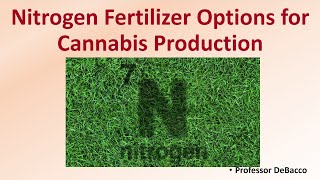Nitrogen Fertilizer Options for Cannabis Production
Nitrogen Fertilizer Options for Cannabis Production

Professor DeBacco
Effects of Nitrogen Fertilizer Rate Timing
Nitrogen can be found in either organic or inorganic forms in the soil.
Organic forms of nitrogen are found when plant and animal material decomposes and releases proteins and amino acids back into the soil as part of the nitrogen cycle.
When organic materials are broken down by bacteria they form inorganic nitrogen as ammonia, in a process called ammonification (Murphy, 2007).
Inorganic nitrogen includes nitrates (NO3-), nitrite, (NO2-), ammonium (NH4+), and dinitrogen gas (N2).
European research had indicated hemp cultivars did not need as much nitrogen compared to wheat (Ranalli, 1999).
Research from Canada Hemp Response to Nitrogen Fertilizer
Research in Canada demonstrated that hemp responded to nitrogen up to 120 kg N/ ha (110 lb N / Acre) when soils were deficient, by increasing seed and biomass yield (Vera et al., 2009).
Research in Saskatchewan showed a positive response to fertilizers, with nitrogen rates up to 150 kg N/ ha (130 lb N / Acre) being optimal (Vera et al., 2009).
In Quebec, Canada, additions up to 200 kg N/ ha (180 lb N / Acre) showed a positive response with no plateau observed (Aubin et al., 2015).
Summary:
Nitrogen rates of 120 kg N/ ha (110 lb N / Acre) to 200 kg N/ ha (180 lb N / Acre) shoul dbe the target range
Ideal target should be around 150 kg N/ ha (130 lb N / Acre)
Nitrogen Transformations
All major soil nitrogen transformations are mediated by various soil microorganisms. Also, the fate of any fertilizer nitrogen source will be subject to the following:
1) Mineralization: conversion of organic nitrogen to inorganic nitrogen by microorganisms
2) Nitrification: conversion of ammonia nitrogen into nitrate
3) Denitrification: conversion of nitrate into a nitrogen gas
4) Ammonia volatilization: loss of ammonia nitrogen as a gas
5) Leaching of nitrates: caused by over-irrigation, especially in sandy soils
6) Immobilization: conversion of inorganic nitrogen into an organic form
7) Ammonium fixation on certain types of clay
N Conversions and Impact on Root-Zone pH
Plants take up ammonium and other positively charged cations by releasing one hydrogen ion (H+) into the medium solution for each ammonium ion absorbed. Over time, ammoniacal nitrogen uptake increases hydrogen ion concentration thereby lowering the growing medium pH.
The uptake of negatively charged anions such as nitrate is most often accomplished by releasing hydroxide ions (OH-). In the medium solution, hydroxide and hydrogen ions combine to form water (H2O). Over time the reaction of hydroxide and hydrogen ions decreases hydrogen ion concentration and increases the medium pH
Impacts of Different % of Ammonium on Root-Zone pH
Rose plants were grown hydroponically in a nutrient solution containing different percentages of ammonium
These effects are much more dramatic than what would occur in a commercial growing medium as it is somewhat buffered due to its chemical properties and added limestone.
Organic Matter and Nitrogen
Soil organic matter will mineralize about 20-40 pounds of nitrogen/acre/year.
95% or more of total N in surface soils is present as organic nitrogen.
Under normal growing conditions, when soils are warm, moist, and well-aerated ammoniacal nitrogen (i.e., ammonium plus ammonia) converts to nitrate in 2-3 weeks, making nitrate the most abundant inorganic form of nitrogen
Chemical Nitrogen Fertilizer Options
Advantages
Quickly available
Contains known and defined amounts of nitrogen
Disadvantages
Can have short residual times requiring repeated applications
Organic Nitrogen Fertilizer Options
Advantages
Often a free source of nitrogen
Material can also have other soil property benefits
Disadvantages
Can also come with other nutrients that may not be needed
Organic vs Synthetic Fertilizers
Link to Lecture Slides: https://drive.google.com/file/d/1jmQXmUtlNdy9iikyeTTgI29oLi8BN1cX/view?usp=sharing
*Due to the description character limit the full work cited for “Nitrogen Fertilizer Options for Cannabis Production” can be viewed at… https://drive.google.com/file/d/1I_WzKUAzkJ2-BCGna0xsBRaSih6G6ZRV/view?usp=sharing

Another great video!..thank you!
Is peters professional with micronutrients good for cannabis 20-20-20
Aloha & the Utah State University Dr. Bugbee and Dr. Heins new Nitrogen recommendation is 165 ppm for Cannabis with 15 ppm NH4 included. This is the formula for coco and peat based substrates.
Question & Hello
Wondering about use of urine, as I’ve seen it used in gardening of vegetables on YT in off grid set ups, Back to the Land gardens etc. to give a nitrogen boost, and of course put a natural resource to work rather than literally flushing it down the drain.
I don’t know the ratio to dilute with water, or if it would be different for cannabis, I quess thats the Question. Thoughts?
**urine of a person/people who are healthy and not pumped full of pharmaceutical medications, of course.
I was just asking myself that question last night. Can I start a grow with synthetic and flower in organically amended soil?
question for you Professor: I am approaching the end of week 4 and my plants are looking great. I did notice however some minor nute burn and a some of my newer leaf growth has been "twisting" is the best way i can describe it. I have had run off of 6.5 6.5 and 6.6 on my last check. Everything else looks great and i am at a loss on the twisting leaves. Is it part of the nute burn? Your insight would be valued and appreciated. Thank you..
Your a great teacher easy to understand my friend!
Hello, professor DeBacco. What category is much correct for nitrogen fixing bacteria? This is organic fertilizer or bacterial fertilizer? Thank you
Negative log of hydrogen ions in solution is pH 🙂 I think you already know 😉 -log(H+) in sol = pH
Thanks. ✌️👊